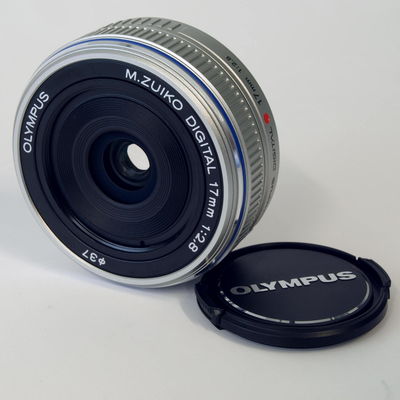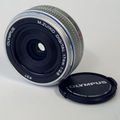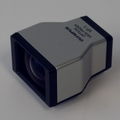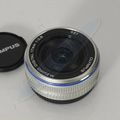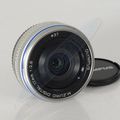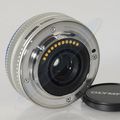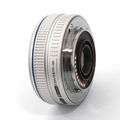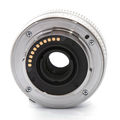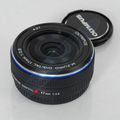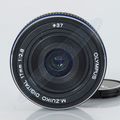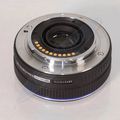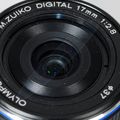M.ZUIKO DIGITAL 17mm F2.8 Pancake
Beschreibung
Das M.ZUIKO DIGITAL 17mm F2.8 Pancake ist ein sehr leichtes (71 g) und kompaktes (Baulänge: 22 mm) Micro Four Thirds Pancake Objektiv.
Es wurde Mitte 2009 zeitgleich mit der E-P1 von Olympus vorgestellt.
Als "Pancake" (engl., deutsch = "Pfannkuchen") werden alle Objektive mit extrem kurzer Bauform bezeichnet. Bis zu welcher Länge (Tiefe) Objektive als "Pancake" bezeichnet werden ist nicht genau definiert, in jedem Fall sollte jedoch der Objektivdurchmesser deutlich größer als die Objektivlänge (Tiefe) sein. Beim M.Zuiko Digital 17mm F2.8 Pancake beträgt der Objektivdurchmesser 57 mm während die Objektivlänge (Tiefe) nur 22 mm beträgt - es handelt sich somit um ein "echtes" Pancake-Objektiv.
Damals - zum Zeitpunkt der Vorstellung der E-P1 - waren Sensoren mit 12 Megapixel "der Stand der Dinge" - und genau für diese Sensoren wurde das M.ZUIKO DIGITAL 17mm F2.8 Pancake gerechnet. Bei den heute üblichen Sensoren (Stand Anfang 2018) mit 20 Megapixel sieht dies leider etwas anders aus: Die Auflösung und mehr (insbesondere bei Offenblende) ist (leider) nicht mehr zeitgemäß, erst abgeblendet erreicht es Werte, die für die aktuelle Sensor-Generation erforderlich sind.
Wenn man ein Pancake für aktuelle mFT-Sensoren sucht, ist hier das Panasonic LUMIX G 20mm F1.7 ASPH. in die engere Auswahl einzubeziehen, welches - trotz höherer Lichtstärke (aber etwas längerer Brennweite) - eine bessere optische Leistung abliefert. Hierbei ist aber zu beachten, dass das Panasonic LUMIX G 20mm F1.7 ASPH. "auf Kontrast und Schärfe optimiert ist", was bei hohen Kontrasten (Bühnenszenen o.Ä.) Probleme bringen kann.
Weitere Festbrennweiten-Alternativen aus dem heutigen mFT-Objektivprogramm:
- LEICA DG SUMMILUX 1:1,7/15 ASPH. - klein, sehr gute optische Leistungen, leider teuer
- M.ZUIKO DIGITAL ED 17mm 1:1.2 PRO - groß, schwer, teuer - aber: unglaubliche optische Leistung, extreme Lichtstärke
- M.ZUIKO DIGITAL ED 17mm F1.8 - die Nutzermeinungen sind nicht eindeutig, viele lieben das Objektiv, viele "werden nicht mit ihm warm"
Olympus-Code: N3593592
Firmware-Updates
Wie auch bei vielen anderen Objektiven liefert Olympus auch hierzu umfangreiche Firmware-Updates:
| Version | Veröffentlichung am | Beschreibung |
| 1.0 | - | Produkteinführung |
| 1.1 | 15.09.2009 | Improved AF operation. |
Zitate
Hier einige Zitate aus "Früher war alles besser…. 17mm Pancake" in pen-and-tell.de:
- "Ein paar Bilder am Testchart: das wird besser, wenn man abblendet. Aber richtig gut werden die Ränder gar nicht."
"Der AF ist tatsächlich laut und langsam – bei späteren Objektiven kam dann „MSC“ als Merkmal auf, das stand dafür, dass man damit filmen kann, ohne dass auf der Aufnahme der AF unangenehm auffällt. Ich hatte das Pancake – siehe oben – an der PEN-F, an den allerersten PENs war der AF echt diskussionswürdig."
"Kaufen? Nein. Es sei denn, man findet den Look affengeil. Leider hat das Objektiv ein Plastikfinish und nach ein paar Kampfkontakten ist die hübsche Optik dahin. Also wenn man zu viel Geld und Platz hat: kaufen, an eine weiße E-P1 montieren und in die Vitrine damit."
Hier ein paar Zitate aus dem Testbericht in photozone.de:
- "The Olympus M.Zuiko 17mm f/2.8 is a lovely little lens but unfortunately it does disappoint regarding its optical capabilities. You expect a top notch performance from a prime lens but the Zuiko isn't perfectly sharp neither at max. aperture nor stopped down - the center quality is perfectly fine but the borders and corners are a bit too soft in general. In principal the lens produces a hefty amount of barrel distortion. However, this problem is auto-corrected by the camera (or by the more popular RAW converters) so this is nothing to worry about from a user perspective. Surprisingly this is not the case with respect to lateral chromatic aberrations (CA) which are fairly extreme with a width of up to 3px at the image borders. The vignetting characteristic is pretty good when stopping down to f/4 and even at max. aperture it's only visible in critical scenes. A nice aspect of the Zuiko is the quality of the bokeh (the out-of-focus blur) - it's very smooth and out-of-focus highlights are rendered beautifully. However, all-in-all the lens leaves something to be desired."
Einige Zitate aus dem Testbericht an einer E-M5 Mark III in robinwong.blogspot.com:
- "Being an older generation lens, the Olympus 17mm F2.8 is very slow to focus. The AF speed is perhaps, one of the slowest for all Micro Four Thirds lenses, and the only other lens I can think of which could be even slower, is the Panasonic 20mm F1.7 pancake. Having said that, the AF on the 17mm F2.8, being used on the E-M5 Mark III, is still quite manageable. It does hesitate and hunt a little before locking onto focus, but it always successfully locked onto the subject and the focusing accuracy is very high. If you need absolute speed, and you shoot a lot of moving subjects or fast action, you are better off with newer Olympus M.Zuiko lenses, such as 17mm F1.8, or the PRO 17mm F1.2, both giving you blazing fast AF performance."
"The Olympus 17mm F2.8 actually exceeded my expectations when it comes to lens sharpness. Perhaps using it on a newer Olympus body with the 20MP image sensor (my E-M5 Mark III) breathed new life into the lens, or maybe my previous copy was less sharp. Looking at the center of the frame, the lens managed to resolve incredible amount of fine details with very good contrast, rendering realistic looking image with pleasing colors. I get sharp images consistently, either shooting subjects that are far, or very close to the lens (a meter or less away). However, the sharpness does not extend consistently to the edges or corners. Placing my subject away from the center of the frame does degrade the sharpness captured, and corner softness is a problem. Knowing that this lens was made to be extremely compact in design, I'd expect some compromises when it comes to image quality, so this did not come as a total surprise. Even the 14-42mm kit lens has better corner sharpness in comparison to this older 17mm F2.8 pancake lens."
Technische Daten
| Hersteller: | Olympus | Bezeichnung: | M.ZUIKO DIGITAL 17mm F2.8 Pancake | |||||||||
|---|---|---|---|---|---|---|---|---|---|---|---|---|
| Brennweite: | 17 mm | Herstellungszeitraum: | 2009 - - | |||||||||
| Lichtstärke: | 2.8 | Blendenbereich: | 2.8 - 22 | |||||||||
| Baulänge: | 22 mm | Durchmesser: | 57 mm | |||||||||
| Gewicht: | 71 g | Filtergewinde: | 37 mm | |||||||||
| Min. Entfernung: | 0,20 m | Max. Abbildungsm.: | 0,11 x (Micro Four Thirds) / 0,22 x (35-mm-Format) | |||||||||
| Bajonett: | Micro FT | Spritz-/Staubschutz: | nein | Bildstabilisator: | nein | |||||||
| Bildwinkel: | 65° | Linsen/Baugruppen: | 6 Elemente in 4 Gruppen | Blendenaufbau: | 5 kreisförmige Lamellen | |||||||
| Innenfokussierung: | nein | Geradführung: | ja | Innenzoom: | entfällt | |||||||
| AF-Antrieb: | Motor | Fokussierung: | by Wire | Zoom: | nein | |||||||
| Besonderheiten: | Pancake; volle Kontrast-AF-Funktionsunterstützung; optischer Aufstecksucher VF-1 optional lieferbar | |||||||||||
Lieferumfang
- M.ZUIKO DIGITAL 17mm F2.8 Pancake Silber oder Schwarz
- Micro Four Thirds Objektivdeckel (LC-37)
- hintere Objektivkappe für Micro Four Thirds Objektive (LR-2)
- Garantieunterlagen und Bedienungsanleitung
Hinweis: wird das M.Zuiko Digital 17mm F2.8 Pancake zusammen mit der E-P1 als Kit verkauft, gehört auch der optische Aufstecksucher VF-1 zum serienmäßigen Lieferumfang.
Galerie
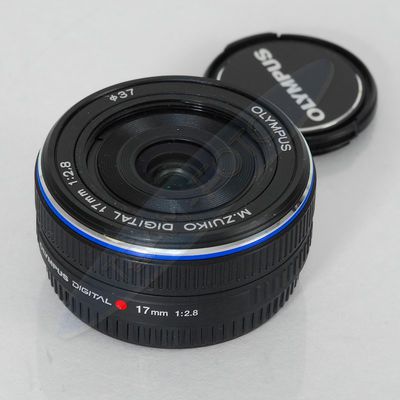
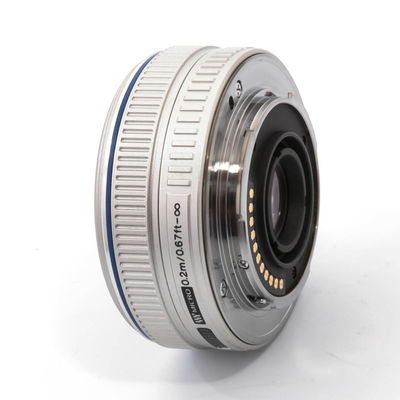
Hier eine kleine Galerie mit Bildern des Objektivs:
M.ZUIKO DIGITAL 17mm F2.8 Pancake (Silber) Micro FT-Objektiv mit serienmäßigem Objektivdeckel
Optional lieferbarer optischer Aufstecksucher für das 17mm F2.8 Pancake, er wird auf den Blitzschuh (Zubehörschuh) der Kamera montiert.
M.ZUIKO DIGITAL 17mm F2.8 Pancake (Silber) - mit freundlicher Genehmigung von team-foto.com
M.ZUIKO DIGITAL 17mm F2.8 Pancake (Silber) - mit freundlicher Genehmigung von team-foto.com
M.ZUIKO DIGITAL 17mm F2.8 Pancake (Silber) - mit freundlicher Genehmigung von team-foto.com
M.ZUIKO DIGITAL 17mm F2.8 Pancake (Silber) - mit freundlicher Genehmigung von arsenal-photo.com
M.ZUIKO DIGITAL 17mm F2.8 Pancake (Silber) - mit freundlicher Genehmigung von arsenal-photo.com
M.ZUIKO DIGITAL 17mm F2.8 Pancake (Schwarz) - mit freundlicher Genehmigung von team-foto.com
M.ZUIKO DIGITAL 17mm F2.8 Pancake (Schwarz) - mit freundlicher Genehmigung von team-foto.com
M.ZUIKO DIGITAL 17mm F2.8 Pancake (Schwarz) - mit freundlicher Genehmigung von team-foto.com
M.ZUIKO DIGITAL 17mm F2.8 Pancake (Schwarz) - mit freundlicher Genehmigung von team-foto.com
Tests und Bewertungen
Zur Einschätzung des Objektivs einige vergleichende Wertungen von DXOmark (jeweils an einer Olympus E-M1 OM-D):
| Objektiv | DxOMark Score | Sharpness | Transmission | Distortion | Vignetting | Chr. aberration |
| Olympus Body Cap Lens 15mm 1:8.0 (außer Konkurrenz) | 5 | 3 MP | F8.0 | 0.4% | -1.5EV | 30µm |
| Olympus M.ZUIKO DIGITAL ED 17mm F1.8 | 22 | 7 MP | F2.0 | 2.0% | -1.1EV | 20µm |
| Olympus M.ZUIKO DIGITAL 17mm F2.8 Pancake | 15 | 6 MP | F3.0 | 2.0% | -1.3EV | 21µm |
| LEICA DG SUMMILUX 1:1,7/15 ASPH. | 21 | 11 MP | F2.0 | 2.7% | -1.1EV | 11µm |
| Panasonic LUMIX G 20mm/F1.7 ASPH. | 22 | 11 MP | F2.1 | 1.5% | -1.6EV | 7µm |
| Panasonic LUMIX G 20mm/F1.7 ASPH. II | 21 | 10 MP | F2.1 | 1.6% | -1.9EV | 7µm |
| Sigma 19mm F2.8 EX DN | 16 | 6 MP | F3.2 | 0.3% | -0.8EV | 15µm |
| Sigma 19mm F2,8 DN [A] | 18 | 7 MP | F3.1 | 0.6% | -0.7EV | 14µm |
